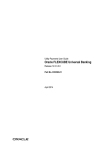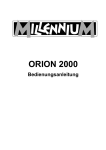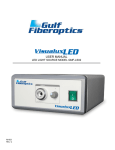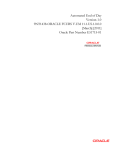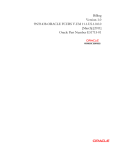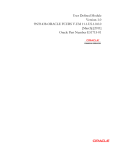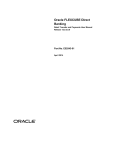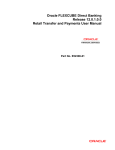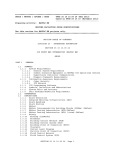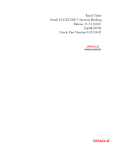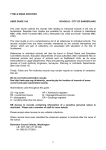Download Utility Payments in this user manual
Transcript
Utility Payments Version-1.0 9NT1438-ORACLE FCUBS V.UM 11.1.US.1.0.0.0 [March] [2011] Oracle Part Number E51715-01 Document Control Author: Documentation Team Group: UBPG Created on: October 01, 2008 Revision No: Final Updated by: Documentation Team Reviewed by: Development/Testing teams Approved by: Software Quality Assurance Team Updated on: March 18, 2011 Reviewed on: March 18, 2011 Approved on: March 18, 2011 Utility Payments Table of Contents 1. ABOUT THIS MANUAL................................................................................................................................ 1-1 1.1 INTRODUCTION ........................................................................................................................................... 1-1 1.1.1 Audience ............................................................................................................................................ 1-1 1.1.2 Organization ...................................................................................................................................... 1-1 1.1.3 Related Documents ............................................................................................................................ 1-2 1.1.4 Glossary of Icons ............................................................................................................................... 1-2 2. OVERVIEW..................................................................................................................................................... 2-1 2.1 INTRODUCTION ........................................................................................................................................... 2-1 2.1.1 Features ............................................................................................................................................. 2-1 3. DEFINING PRODUCTS FOR UTILITY PAYMENTS .............................................................................. 3-1 3.1 INTRODUCTION ........................................................................................................................................... 3-1 3.1.1 Advantage of Defining Product ......................................................................................................... 3-1 3.1.2 Attributes of Product.......................................................................................................................... 3-1 3.2 PAYMENT TRANSACTIONS .......................................................................................................................... 3-2 3.3 PRODUCTS FOR UTILITY PAYMENT TRANSACTIONS ................................................................................... 3-2 3.4 CREATING PRODUCTS FOR UTILITY PAYMENT TRANSACTIONS .................................................................. 3-4 3.4.1 Features of Utility Payment Product Definition Main Screen ........................................................... 3-4 3.4.2 Defining Other Attributes of Utility Payment Products ..................................................................... 3-6 3.4.3 Saving Utility Payments Product ....................................................................................................... 3-6 3.4.4 Specifying Accounts Details............................................................................................................... 3-7 3.4.5 Specifying Charge Details ................................................................................................................. 3-7 4. ACCOUNTS DETAILS AND CHARGES .................................................................................................... 4-1 4.1 MAINTAINING ACCOUNTS DETAILS AND CHARGES - UTILITY PRODUCTS .................................................. 4-1 4.1.1 ARC Maintenance Screen .................................................................................................................. 4-2 5. PROCESSING BILL PAYMENTS ............................................................................................................... 5-1 5.1 MAKING BILL PAYMENTS........................................................................................................................... 5-1 5.2 MAINTAINING UTILITY PROVIDER TYPE .................................................................................................... 5-1 5.2.1 Specifying User Defined Fields ......................................................................................................... 5-2 5.3 MAINTAINING BILL PARAMETERS .............................................................................................................. 5-3 5.3.1 Specifying User Defined Fields ......................................................................................................... 5-4 5.4 MAINTAINING BILL INSTRUCTIONS ............................................................................................................ 5-5 5.4.1 Viewing Execution Log ...................................................................................................................... 5-8 5.4.2 Specifying User Defined Fields ......................................................................................................... 5-9 5.5 MAINTAINING PRODUCTS FOR UTILITY BILL PAYMENTS ........................................................................... 5-9 5.5.1 Specifying Check Details ................................................................................................................. 5-10 5.6 SPECIFYING REMITTER DETAILS .............................................................................................................. 5-12 5.6.1 Viewing Accounting Entries and Overrides..................................................................................... 5-13 5.7 VIEWING UTILITY PAYMENT TRANSACTION ............................................................................................ 5-14 5.8 VIEWING BILL DETAILS............................................................................................................................ 5-15 5.9 VIEWING TRANSACTION DETAILS ............................................................................................................ 5-15 5.10 EXECUTING BILL PAYMENT BATCH ......................................................................................................... 5-15 1. About this Manual 1.1 Introduction This manual is designed to help acquaint you with the Utility Payments Module of Oracle FLEXCUBE. It provides an overview of the module and guides you, through the various steps involved in processing utility payments of the customers of your bank. You can further obtain information about to a particular field by placing the cursor on the relevant field and striking the <F1> key on the keyboard. 1.1.1 Audience This manual is intended for the following User/User Roles: Role Function Back office data entry clerk Input functions for contracts. Back office managers/officers Authorization functions. Product Managers Product definition and authorization. End of Day operators Processing during End of Day/ Beginning of Day. Financial Controller / Product Managers Generation of reports. 1.1.2 Organization This manual is organized into the following chapters: Chapter 1 About this Manual gives information on the intended audience. It also lists the various chapters covered in this User Manual Chapter 2 Overview is a snapshot of the features that the module provides. Chapter 3 Defining Products for Utility Payments details the procedure to set up products for utility payments. Chapter 4 Accounts Details and Charges explains the process of setting up details of accounts and charges for a utility product, applicable for payment transactions, is explained in this chapter Chapter 5 Processing Bill Payments deals with the procedure involved in entering the details of a utility payment transaction for a customer, against an issued bill. 1-1 1.1.3 Related Documents • The Core Services User Manual • The Core Entities User Manual • The Procedures User Manual 1.1.4 Glossary of Icons Icons Function New Copy Save Delete Unlock Print Close Re-open Reverse Template Roll-over Hold Authorize Liquidate Exit Sign-off Help Add row Delete row 1-2 2. Overview 2.1 Introduction The Payments Utility Interface module enables your bank to process payments made by customers towards services and utilities provided by specific utility providers. Customers may need to make these payments from any branch of your bank to any other branch of your bank. For each kind of payment, you can define a product in the UP Product Definition screen. You can make the use of the product specific to payments made to a specific utility provider, for a particular utility payment, and a particular payment currency, by defining ARC details in the ARC Maintenance screen. You can capture details of each payment of a customer against a bill, in the Bill Payments by Account, Check or Cash screens, depending upon the mode of payment. 2.1.1 Features The Payment Utility Interface module enables you to process utility payments made by customers, by providing the following features: • Flexible definitions of accounting entries and events involving payments • Definition of charges applicable • Definition of exchange rates applicable for cross-currency conversions • Inter-branch payment transactions can be processed 2-1 3. Defining Products for Utility Payments 3.1 Introduction A product is a specific service, facility, scheme or utility that you make available to customers of your bank. For instance, processing payments made by customers for utility services, to a utility provider institution could be thought of as a product. 3.1.1 Advantage of Defining Product When you process a utility payment transaction for a customer, you need to provide the following details: • Any applicable charges levied for the service of processing payments • The specific accounts that would be impacted (debited or credited) when the payment takes place • The exchange rates that would apply in the case of cross currency conversions that may need to be done when a payment is processed • The transaction codes under which accounting entries would be posted for each leg of the transaction • For an inter-branch transaction, you would need to specify the branch in which the debit account resides To avoid capturing these details each time a payment transaction is processed, you can define a product. You can specify all the details mentioned above and define a specific set of accounts, charges and rates for each utility provider for whom you need to process payment transactions. These details can then be mapped to the product. Whenever you process a payment made by a customer to the utility provider, against the product, the system applies all the specifications made for the product to the transaction, and you need not specify them afresh. 3.1.2 Attributes of Product A product is characterized by its attributes. The attributes are options that you define that will apply to any actual transactions that will be processed against the product. In the case of a product that you create to process utility payments made by a customer to a utility provider, you can define a specific set of accounting details, applicable charges and rates that would apply to each specific utility provider. These details can be mapped to the product. 3.1.2.1 Other Attributes The following are the other attributes you could define for a utility payments product: • The user-defined fields that you would want to use for entering transactions against the product 3-1 • 3.2 The management reporting (MIS) details for transactions involving the product. Payment Transactions A transaction is a specific operation with financial implications (such as a payment) that involves two or more entities. A customer who approaches your bank to avail of any of the services offered by your bank enters into a transaction or contract with your bank. In the case of utility payments of customers, the entities involved are the customer, your bank and the utility provider. The utility provider is the institution in whose favor a customer makes payments, and on whose behalf your bank has agreed to accept and process such customer payments. In Oracle FLEXCUBE, a transaction is entered into the system against a product. For instance, a payment made by a customer towards electricity charges could be entered into the system against a product defined for processing electricity charges payments, with accounting details, rates and charges defined specifically for the utility provider that is the recipient of the payment. When Oracle FLEXCUBE processes the transaction, it will apply all the attributes and specifications made for the product against which the transaction was entered. You can enter more than one payment transaction in favor of a utility provider, against a product that has been created specifically for the utility provider. 3.3 Products for Utility Payment Transactions When you define products for processing payment transactions of customers, you need to: • Define an unique product for each type of utility payment transaction that your bank would process for customers. Example In your bank, you have offered customers the service of processing the following types of utility payments to the appropriate utility providers: • Water Charges • Electricity Charges • Credit Card Statement Payments • Telephone Charges To process each type of utility payment, you can define a utility product. Therefore, you could create the following products: • WCUP, for processing water charges payments of customers • ECUP, for electricity charges payments • CCUP, for credit card statement payments • TCUP, for telephone charges payments 3-2 • You will have to define the utility provider who will be the recipient of each type of utility payment made by a customer. The details of accounts to which entries will be posted for payments, exchange rates for cross currency conversion, and any charges that your bank would levy, on utility payments of any type accepted from customers towards each utility provider would be different. Therefore, you would need to map these details to the corresponding product that you have created. Example One of your customers, Mr. Philip Smythe, makes credit card statement payments through your bank. On Mr. Smythe’s statement, the due amounts are expressed in Australian Dollars. He has an USD account in your bank, through which he makes the payments. The payments are made to Global Credit Solutions Limited, who also have an USD account in your bank. You have maintained a product, CCUP, for processing credit card statement payments of customers. You can use this product to process any credit card statement payments of Mr. Philip Smythe. To do so, you need to: • Associate the standard AUD-USD rates that you have defined in the system, to the product CCUP • Associate Mr. Smythe’s USD account in your bank, as well as the account held by Global Credit Solutions Limited, with the product CCUP, as the debit and credit accounts respectively. • Define any charges that your bank would levy for the service of processing credit card statement payments, and associate these with the product CCUP. A product that you define for processing utility payments of a specific type, to which you have attached any accounting details, rates and charges applicable to a specific utility provider, cannot be used to process payment transactions for any other utility provider. Example The following utility providers, PowerCorp Limited have designated your bank as authorized to receive utility service payments made by customers towards them, and credit the same into their account with your bank: • PowerCorp Limited (electricity providers) • Springwell Water Resources (water supply providers) • Communications Global (telephone service providers) Mr. Alfred Werker, a customer of your bank, makes payments for electricity charges, water charges and telephone charges to these institutions, through your bank. You have already defined three products, WCUP, ECUP and TCUP (see example above) for each type of payment. The charges that you levy for processing each kind of payment could be different for each utility provider. Also, the accounts that would be impacted and the currencies involved would be different for each of the payments. For instance, the account that would be impacted when Mr. Werker makes an electricity payment would be PowerCorp’s account with your bank. Whereas, when he makes a water supply payment, it would be Springwell’s account with your bank. Also, the charges that would be levied in each case would be different. In view of this, you would need to define three different sets of accounting and charges details for each kind of payment, for each utility provider, one each for processing electricity charges payment, water charges payment and telephone charges payment. Having defined these accounting and charges details, you will need to map these details to the corresponding product, for each of the utility providers mentioned above. 3-3 For instance, when you define the account that would be impacted with Mr. Werker’s electricity payment as PowerCorp’s account, and define appropriate charges, you must map these details to the product ECUP. If a second electricity services provider, say Global Power Resources, also designates your bank as authorized to accept electricity charges payments made by customers, you can define another product, other than ECUP, and set up specific accounting and charges details for the same. Alternatively, you could use the same product ECUP, and define a different set of accounting and charges details that would be applicable to payments made by customers to Global Power Resources. 3.4 Creating Products for Utility Payment Transactions To create a product for utility payments of customers, you must specify basic details such as the Product Code, Group, Description, and so on in the ‘UP Product Definition’ screen. You can invoke this screen by typing ‘UPDPRDMN’ in the field at the top right corner of the Application tool bar and clicking on the adjoining arrow button. In this screen, you can only set up a basic profile for the product. You cannot associate any account details or charge details for a specific utility provider. To maintain these details for a specific utility provider for a specific product, you must use the Accounting Rates and Charges Maintenance (ARC) screen. Refer to the chapter Accounts Details and Charges in this user manual, for information about the ‘ARC Maintenance’ screen. 3.4.1 Features of Utility Payment Product Definition Main Screen You must specify the following details for a utility product in the UP Product Definition main screen: • An identifier or code for the product, which is unique to it • A concise description of the product 3-4 • A slogan for the product • The group under which the product is classified • The life-span of the product • Any narrative regarding the product (remarks) • The limits with regard to exchange rate variance that would apply to any transactions involving the product Product Code The product code is a unique identifier for the product in the system, across all modules. You can specify a code consisting of four characters. You cannot use the code that you specify here for any other product in the system, in any module. If, for instance, you have specified PWBL as the product code for a utility product in this screen, you cannot specify the same code for any other product in any other module in the system. For any utility product, you must specify a code. Specify an indicative code, for instance, in our example of Mr. Philip Smythe’s credit card statement payments, you could define CCUP as the product code for a product used to process credit card payments. Product Type The product type indicates the category under which the product can be placed, and the type of transaction that will be processed against the product. A utility payments product can only be used to process utility payments made by customers in favor of a particular utility provider. Product Description Give a brief description of the product. This description can be used to easily locate and retrieve information regarding the product. For any utility product, you must specify a description. Specify an indicative description; for instance, in our example of Mr. Philip Smythe’s credit card statement payments, for the product CCUP, you could specify “Credit card statement payments” as the description. Slogan Specify a catchphrase for the product. You could specify a marketing motto, or any other saying that encapsulates the product in a few short words. For any utility product, you must specify a slogan. Product Group Products are classified into different groups, based on similar characteristics. The classification makes it simple to retrieve information about a class of products. A list of product groups maintained in the Product Group Definition is displayed in the list box, from which you can select the appropriate group. 3-5 Start and End Date To recall, a product is a scheme or service that your bank offers customers. Typically, a scheme or service is available to customers within a fixed period. This period is the life span of the product. You specify the product life span by providing a Start Date and an End Date. The period between the two dates is when the product is available for use. If you do not specify an end date, the product can be used indefinitely, or until it is closed. Remarks You can specify information about a product that will be used for reference, within your bank. It will not be printed on any correspondence with customers, but will be displayed when the details of any payment transaction involving the product are displayed or printed. 3.4.2 Defining Other Attributes of Utility Payment Products After specifying all these basic details of a product, you can indicate certain specific attributes for the product. Each of these attributes can be defined in the corresponding screen that you can invoke from the ‘UP Product Definition’ main screen, by clicking the appropriate icons. Attributes with common characteristics are grouped together in common screens, simplifying the process of defining them. Click ‘Fields’ button to specify any user-defined fields that would be required during entry of transactions involving the product. Click ‘MIS’ to specify any MIS details that would be applicable for any utility payment transactions involving the product. 3.4.3 Saving Utility Payments Product After you have specified all the mandatory information required for the product in the product definition screens, you could save the product. You will not be allowed to save the product until you have specified all the mandatory information. When you save the product, the following information is updated and displayed in the status bar of the UP Product Definition screen: • Your User ID in the Input By field • The date and time at which you entered the product, in the Date Time field Also, the status of the product is updated as Open and Unauthorized. Another user with authorization rights must authorize it, before you can begin to use it. 3-6 3.4.4 Specifying Accounts Details To recall, you maintain a utility payments product to process a specific kind of utility payment made by customers. In order to configure a product to process a specific type of payment made by customers, in favor of a specific utility provider, you also need to specify the details of the accounts or GL’s to which accounting entries need to be posted for any payment transaction, for the utility provider. You specify these accounts details in the ARC Maintenance screen, for each specific utility provider. You also map the appropriate product to these details. When you do so, the product – accounting details combination can then be used to process only all those payments made by customers to the specific utility provider to whom the accounts details are applicable. To use the same product to process specific payments made by customers in favor of a different utility provider, you will need to set up another set of accounting details that are specific to the utility provider in the ARC Maintenance screen, and associate these details with the product. Invoke the ‘ARC Maintenance’ screen from the Application Browser. For a full discussion of this screen, refer the chapter Accounts Details and Charges in this user manual. 3.4.5 Specifying Charge Details When you process utility payments made by customers, your bank may need to levy certain service charges for each utility provider. You can specify these charges specifically for a utility provider, in the ARC Maintenance screen, and associate the product you have created, with these charges. Whenever you use the product to process a utility payment made to the utility provider for whom you have defined the charges in the ARC Maintenance screen, they are applied by default. You can override these default charges, if necessary. Invoke the ‘ARC Maintenance’ screen from the Application Browser. For a full discussion of this screen, refer the chapter Accounts Details and Charges in this User Manual. 3-7 4. Accounts Details and Charges Maintaining Accounts Details and Charges - Utility Products 4.1 The institution or utility provider The entities that are recipients of any kind of utility payments made by customers are known as receiving institutions or utility providers. For instance, a company that provides telephone services, in favor of whom a customer may make payments for telephone services, is one type of utility provider. After you have defined a utility payments product to process a specific kind of utility payment of customers, you must configure the product to process payments made to a specific utility provider. To do this, you must specify the following details for the product: • The details of accounts or GL’s to which accounting entries would be posted when the utility payments are processed. This would be specific to each utility provider, since the debit and offset accounts for a payments transaction would presumably be different for each utility provider. • The utility provider or the institution that would be the recipient for any payments of the type for which you have defined the product, made by customers. • The currency in which payments would be accepted • The details of any charges that your bank would need to collect or levy, for the service of processing the utility payment. These details could again be specific to each utility provider. Example Global Credit Solutions Limited, a credit company, who have an USD account in your bank, have designated your bank as authorized to accept credit card statement payments of their clients, and credit the payments to their USD accounts. One of your customers, Mr. Philip Smythe, makes credit card statement payments to Global Credit Solutions through your bank. He has an USD account in your bank, through which he makes the payments. You have maintained a product, CCUP, for processing credit card statement payments of customers. You can use this product to process any credit card statement payments made by customers such as Mr. Philip Smythe, in favor of Global Credit Solutions Limited. To do so, you need to: • Specify the ID of Global Credit Solutions Limited, as the receiving institution for any credit card payments made by any customers, such as Mr. Philip Smythe. • Associate Global Credit Solutions Limited’s USD account in your bank, with the product CCUP, as the offset or credit account that will be credited with all credit card payments made by customers (such as Mr. Smythe) in favor of them, through your bank. • Specify USD as the currency in which payments would be accepted • Specify the account that will be debited for credit card statement payments, made in cash, by any clients of Global Credit Solutions Limited, through your bank, who do not have an account in your bank. 4-1 • Define any charges that your bank would levy for the service of processing credit card statement payments made in favor of Global Credit Solutions Limited, and associate these with the product CCUP. • Associate the standard AUD-USD rates that you have defined in the system, to the product CCUP Throughout our discussion of how accounts details and charges information is specified for a utility product, in this chapter, we will be referring to the example given above. 4.1.1 ARC Maintenance Screen The ‘ARC Maintenance’ screen allows you to maintain these details for any utility product against which you process utility payments made by customers in favor of a specific utility provider. Through this screen you can perform the following tasks while posting accounting entries related to utility payment transactions involving a utility product in Oracle FLEXCUBE: • Specify the Accounting entry definition • Indicate the Exchange Rate specifications for any charges • Capture the Charges that should be levied. You can invoke this screen by typing ‘IFDATMMN’ in the field at the top right corner of the Application tool bar and clicking on the adjoining arrow button. The accounts details and charges details (or ARC details) can be specified to be applicable either for an account class or a product type. You need to indicate this in the ARC Maintenance screen. 4-2 If you are maintaining ARC details for an Account Class, the ARC details maintained in this screen will be used for posting entries for the Account Class and ATM Transaction Type combination. If you are maintaining ARC details for a utility product and a specific utility provider (or institution), the ARC details maintained in this screen will be used for posting entries for the utility product, Institution ID and currency code combination. The institution ID is the identification of the utility provider that will be the recipient of the utility payment being made by customers. You must maintain ARC details for each specific utility provider for whom you process customer payments made in favor of the utility provider. A unique, single set of ARC details must be maintained for each utility provider. You can, however, associate a utility product with many different ARC details sets. Therefore, you can use a particular utility product to process payments made in favor of any utility provider, but you must maintain distinct ARC details for each individual utility provider. Since the ARC related detail are maintained at the Head Office of your bank, the details that you specify in this screen will be made applicable to all the branches of your bank. Account Class/Product While maintaining the ARC details for a utility provider, you have to indicate the particular product that would be used to process payments made by customers in favor of the utility provider, from the available list. Each product in Oracle FLEXCUBE is identified with a unique four character alphanumeric code. You can indicate the appropriate utility product. Similarly, if you are maintaining the ARC details for an Account Class you can identify the appropriate Account Class from the existing list of account classes. 4-3 Example In our example of Mr. Philip Smythe’s credit card statement payments to Global Credit Solutions Limited, you can indicate CCUP as the product for which you are maintaining ARC details in this screen. This is the product that you have defined for the purpose of processing credit card statement payments for customers. Currency You must indicate the currency in which the utility provider would accept utility payments made in favor of the utility provider involving the selected utility product. Example In our example, since Global Credit Solutions accepts credit card payments made in favor of them in USD, you must indicate USD as the Currency Code in this screen. For each currency in which the utility provider accepts utility payments made in favor of the utility provider, you must maintain a separate set of ARC details in this screen. For instance, in our example, if Global Credit Solutions Limited also proposes to receive utility payments into their GBP account in your bank, you need to maintain a separate set of ARC details in this screen for the product CCUP, Currency Code GBP, and the receiving institution Global Credit Solutions Limited. 4.1.1.1 Specifying ATM Transaction Type You have to specify the type of ATM transaction for which you are defining the ARC details. In Oracle FLEXCUBE, each ATM transaction type is associated with a processing code. While processing a transaction, the processing code will uniquely identify the type of transaction for which the ARC definition has been maintained. While processing ATM transactions the system picks up the corresponding Oracle FLEXCUBE ATM processing code from the ATM Server based on the ATM Transaction type. 4.1.1.2 Specifying Institution ID You must specify the ID of the utility provider for whom the ARC details are being maintained in this record. These ARC details would be applicable for all payments to the utility provider, involving the selected utility product and made in the selected currency. Select the appropriate ID from the options list. Example The recipient of Mr. Philip Smythe’s credit card statement payments is Global Credit Solutions Limited, who are your customers and have an account in your bank. You must select the CIF of this institution from the option list. For each institution that would be a recipient of utility payments, you must maintain a separate set of ARC details in this screen. For instance, in our example, if Mr. Smythe also makes credit card payments to a different receiving institution (utility provider), say Central Bank, in GBP, you need to maintain a separate set of ARC details in this screen for the product CCUP, Currency Code GBP, and the receiving institution (Central Bank) combination. 4-4 4.1.1.3 Identifying Offset Details You can specify the Branch and the offset account or GL into which offset entries are to be booked. This will be the account that would be credited with the payment. Typically, this is the account held by the utility provider in your bank. Example The receiving institution, in the case of Mr. Smythe’s credit card payments, is Global Credit Solutions Limited. It is their account (or specific GL) with your bank that would be credited when Mr. Smythe makes a payment against a credit card statement. Therefore, you must select the number of their account with your bank as the offset account. If the receiving institution (or utility provider) has different accounts in your bank in different currencies, and proposes to receive payments in any of those currencies, you must maintain a distinct set of ARC details in this screen for each of the accounts. 4.1.1.4 Identifying Transaction Details For walk-in customers who do not hold accounts in your bank, and who are making cash payments to the selected utility provider, you must specify the account that must be debited (to which debit entries will be posted), as well as the branch in which this account resides. The branch information could also be used in the case of an inter-branch payment transaction. Example Mr. Edward Smith, a walk in customer, makes his credit card statement payments to Global Credit Solutions Limited by cash through your bank. In this field, you must specify the cash account that will be debited for this payment as the transaction account. 4.1.1.5 Identifying Transaction Codes In addition, you have to also identify the transaction codes against which offset and debit related entries for the payment ought to be tracked. Indicating the netting of debit leg of charge You have the option to net the accounting entries for the debit leg of the charges along with the main transaction entries. Check this box to indicate that the debit leg of the charges is to be netted before passing the accounting entries. Leave the box unchecked to pass the entries without netting the charges of the debit leg. Generating transaction advice Whether an Advice needs to be generated for the Transaction (redundant for J2EEBranch, might still be used for other Interfaces). Float days basis Whether to consider the Calendar Days or Working Days for computing the Value Date based on the Floats maintained. 4-5 Bank float days In case Bank Float Days is not maintained at the Clearing Bank/Branch level, it is picked up from here. Customer float days In case Customer Float Days is not maintained at the Clearing Bank/Branch level, it is picked up from here. Description End Point Description (Display Only field). 4.1.1.6 Defining Charge Details You can define a maximum of five charges. A charge can be computed based either on the transaction amount or on an earlier charge amount As part of defining the Charge details for each charge, you need to capture the following details in the corresponding charge tabs: Charge Type The Charge Type that should be applied on the transaction. It could either be a Percentage of the transaction amount or a Flat Charge. Slab Type Select whether the Charge computation has to be over different Amount Slabs or Tiers (0-100 @ 10, 101-500 @ 15 etc.). Basis You can indicate the basis amount on which the charge is to be computed. Since you can maintain five different charge amounts, the basis amount that you enter could either be the transaction amount or any of the earlier charge amounts. For example, let us assume you are maintaining Charge 1. The only basis for charge 1 can be the transaction amount. While defining Charge 2 you can choose either the transaction amount or Charge 1 as the basis. Similarly while defining Charge 3, you can choose the transaction amount or Charge 1 or Charge 2 as the basis. Currency You can indicate the currency in which the charge amount would be expressed. If the transaction currency is different from the charge currency, a conversion would be done, using the rate code and rate type that you specify for each charge. Charge Account You can specify the charge account into which charge related entries are to be posted. 4-6 Netting Charge If two or more accounting entries, for the same event, are to be passed to the same account, on the same Transaction Date, these entries can be netted. You can choose to net the charge leg of the Transaction Account (debit) entry with the main leg of the customer accounting entry. Transaction Code You can indicate the code using which the accounting entries would be booked, for each charge. Rate Code and Rate Type While settling charges for cross currency transactions, you can choose to debit the customer by applying the mid rate, buy rate or by using the buy/sell spread over the mid-rate. Therefore you need to specify the Exchange Rate details for each ARC definition record that you maintain in the system. Firstly, indicate the Rate Code for which different rates can be maintained. A list of all the rate codes maintained in the Floating Rates Maintenance screen is displayed in the list. You can choose the appropriate code. In addition to specifying the Rate Code you have to indicate the Rate Type which should be picked up for exchange rate conversions involving settlement of charges for cross currency transactions. You can maintain any one of the following as the Rate Type: • Buy • Mid • Sell After identifying the Rate Code and Rate Type you can indicate the basis amount on which charges are to be computed. Charge Amount You have to specify the flat amount only when the charge type is a Flat Amount. The flat amount will be collected in the currency that you have specified in the Currency Code field. Rate If you have indicated that the charge should be a percentage of the transaction amount, you have to necessarily capture the rate that is to be applied on the transaction amount. The rate that you specify will be applied after converting the amount into the Account Currency. Minimum and Maximum Charge Amount When the charge type applicable on the transaction is a percentage of the transaction amount you have to capture the minimum and maximum charge amounts that should be applied on the transaction. 4-7 If the charge percentage involving a particular transaction is less than the minimum charge the system will by default debit the customer account with the minimum charge amount. Similarly, when the charge percentage exceeds the maximum amount, the system will debit the customer account with the maximum charge amount. The charge amount will be deducted in the currency that you specified earlier. MIS Head Specify the MIS Head that is applicable for the charge-related accounting entry. Description You can indicate a short description for the charge. 4-8 5. Processing Bill Payments 5.1 Making Bill Payments A customer of your bank could choose to make payments for utility services, to the required institutions or utility providers against bills issued by them, through your bank. Such payments are bill payment transactions. In a bill payment transaction, the entities involved in a contract are the customer, your bank and the institutions (utility providers) that are the recipients of the bill payment. Example One of your customers, Mr. Philip Smythe, makes credit card statement payments to Global Credit Solutions Limited through your bank. On Mr. Smythe’s statement, the due amounts are expressed in Australian Dollars. He has an USD account in your bank, through which he makes the payments. Global Credit Solutions Limited, who are the utility providers, have an USD account in your bank. st Mr. Smythe’s first credit card statement is issued by Global Credit Solutions Limited, dated 1 August 2002. rd The amount to be paid is 200 AUD. Mr. Smythe makes payment against this card statement on 3 August 2002. Entering the details of Mr. Smythe’s payment against this statement constitutes a utility payment transaction in Oracle FLEXCUBE. You have maintained a product, CCUP, for processing credit card statement payments of customers. You have also defined the following details in the ARC Maintenance for the product CCUP and the utility provider Global Credit Solutions Limited so that you can use it to enter and process the payment transaction for Mr. Smythe: 5.2 • The ID of Global Credit Solutions Limited, as the receiving institution or utility provider for any credit card payments made by customers such as Mr. Philip Smythe. • The USD account held by Global Credit Solutions Limited in your bank has been associated with the product CCUP, as the credit account that will be credited with credit card payments made by customers such as Mr. Smythe. • USD as the currency in which payments would be accepted by Global Credit Solutions Limited • Any charges that your bank would levy for the service of processing credit card statement payments for Global Credit Solutions Limited have been defined and associated with the product CCUP. • The standard AUD-USD rates that you have defined in the system are also associated with the product CCUP Maintaining Utility Provider Type You can maintain different types of utility providers using the ‘Utility Provider Type Maintenance’ screen. 5-1 You can invoke this screen by typing ‘UPDTPMNT’ in the field at the top right corner of the Application tool bar and clicking the adjoining arrow button. You can specify the following details: Utility Provider Type Specify a unique identifier for the utility provider type. The code can be alphanumeric and can have a maximum of 35 characters. Utility Provider Type Description Give a brief description for the utility provider type. You can specify a maximum of 105 alphanumeric characters. 5.2.1 Specifying User Defined Fields You can specify values for all user-defined fields (UDFs) linked to the function ID, in the ‘User defined Fields’ screen. 5-2 Click ‘Fields’ button on the‘Utility Provider Type Maintenance’ screen. Refer the User Defined Fields module chapter under Modularity for further details about UDFs. 5.3 Maintaining Bill Parameters You can maintain bill parameters for utility providers using the ‘Utility Bill Structure Definition’ screen. You can invoke this screen by typing ‘UPDBILDT’ in the field at the top right corner of the Application tool bar and clicking the adjoining arrow button. You can specify the following details: 5-3 Utility Provider Type Specify the utility provider type for which you are maintaining parameters. The adjoining option list displays all valid utility provider types maintained in the system. You can select the appropriate one. Utility Provider Type Description Based on the utility provider type, the system displays the corresponding description. Utility Provider ID Specify the CIF of the utility provider. The adjoining option list displays all valid CIF of type ‘Utility Provider; maintained in the system. You can select the appropriate one. Field Label You can capture five entities that should be captured in the bill. Field 1 to 5 Specify the name of the entity for which value has to be captured during bill payment. Field Name You can capture the name of field in UP module to which each label needs to be mapped. The following value is available in the adjoining drop-down list: • Consumer No. Note that you need to map one label to the field ‘Consumer No.’. For the remaining four labels, you need not specify the UP field mapping. 5.3.1 Specifying User Defined Fields You can specify values for all user-defined fields (UDFs) linked to the function ID, in the ‘User defined Fields’ screen. 5-4 Click ‘Fields’ button on the‘Utility Bill Structure Definition’ screen. Refer the User Defined Fields module chapter under Modularity for further details about UDFs. 5.4 Maintaining Bill Instructions You can maintain bill payment instructions for utility providers using the ‘Utility Bill Details’ screen. You can invoke this screen by typing ‘UPDAUINS’ in the field at the top right corner of the Application tool bar and clicking the adjoining arrow button. 5-5 You can capture the following details: Instruction Reference Number The system generates a unique identifier for the instruction and displays it here, on saving the record. Branch Code The current logged-in branch is displayed here. Customer Id Specify the Customer Identification Number (CIF) of the customer for which payment instructions are being maintained. The adjoining option list displays all valid CIF maintained in the system. You can select the appropriate one. Utility Provider ID Specify the CIF of the utility provider. The adjoining option list displays all valid CIF of type ‘Utility Provider; maintained in the system. You can select the appropriate one. Utility Provider Type Specify the utility provider type for which you are maintaining instructions. The adjoining option list displays all valid utility provider types maintained in the system. You can select the appropriate one. Utility Provider Type Description Based on the utility provider type, the system displays the corresponding description. Parameters The system picks up all parameters maintained for the utility provider type and displays them here. You can specify values for each one of them. First Execution Date Indicate the date from which the instruction should be executed, using the adjoining calendar. Next Execution Date The system computes the next execution date based on the execution frequency and displays it here. Last Execution Date Indicate the date on which the instruction should be executed for the last time, using the adjoining calendar. 5-6 Execution Frequency Select the frequency of instruction execution from the adjoining drop-down list. It can be any one of the following: • Monthly • Quarterly • Half Yearly • Yearly Execution Retry Count Specify the number of times that the payment execution should be re-tried within the execution frequency, in case of failure. The retry happens on the next working day after the execution fails. You can specify the maximum value as ‘99’. Collection Mode Select the collection mode from the adjoining drop-down list. It can be any one of the following: • Collect Full • Collect Partial For ‘Collect Partial’ mode, if the debit account balance is less than the bill payment amount, then the system will take the available amount that can be paid and settle the remaining amount as per the retry definition. For ‘Collect Full’ mode, if the debit account balance is less than the bill payment amount, then no payment will be made. The system will continue to recover the complete payment amount as per the retry definition. Payment Mode Select the payment mode from the adjoining drop-down list. It can be any one of the following: • Full • Partial If you select ‘Full’, then the entire bill amount will be considered paid; else only the amount specified in the ‘Payment Amount’ field will be considered paid. Payment Currency Specify the currency in which payment has to be made. The adjoining option list displays all valid currency codes maintained in the system. You can select the appropriate one. Payment Amount In case of a partial payment, specify the amount that should be paid. 5-7 Debit Branch Specify the branch where the debit account resides. The adjoining option list displays all valid branch codes maintained in the system. You can select the appropriate one. Debit Account Specify the account that should be debited for making the bill payment. The adjoining option list displays all accounts maintained in the debit branch (in the system) for the customer ID. You can select the appropriate one. 5.4.1 Viewing Execution Log Click ‘Execution Log’ button and invoke the ‘Execution Log Details’ screen. Here you can view the following details: • Instruction Reference Number • Utility Provider ID • Customer ID • Execution Date • Debit Branch • Debit Account • Payment Currency 5-8 • Actual Bill Amount • Status • Payment Mode • Payment Amount • Maximum Retry Count • Retry Count • Paid Bill Amount • Status • Error Code • Message 5.4.2 Specifying User Defined Fields You can specify values for all user-defined fields (UDFs) linked to the function ID, in the ‘User defined Fields’ screen. Click ‘Fields’ button on the‘Utility Bill Details’ screen. Refer the User Defined Fields module chapter under Modularity for further details about UDFs. 5.5 Maintaining Products for Utility Bill Payments A product is a specific service, scheme or facility that you make available to customers. For instance, the facility of accepting payments from customers on behalf of utility providers for bills issued by them for utility services is a specific service you could offer. This service can be thought of as a product. 5-9 In Oracle FLEXCUBE, a bill payment transaction for a customer is entered into the system against a specific product that has been created for processing particular types of utility payments made by customers in favor of specific utility providers. For instance, electricity charges payment made by a customer to a specific electrical services provider is entered into the system against a product created specifically for the utility provider, for electricity charge bill payments. Defining a product simplifies the process of entering a transaction, since you can associate a product with certain accounting and charges details that will be applied to all payment transactions entered against the product automatically, saving your effort to specify them afresh each time you input a transaction. When Oracle FLEXCUBE processes the transaction, it will apply all the attributes and specifications made for the product against which the transaction was entered. You can enter more than one payment transaction of a customer for a specific service against a product created for the utility provider. Before you enter any payment transactions for a utility provider, you should have already defined a specific product to process payments against bills issued against the specific service provided by the utility provider. The definition of products for utility payments is explained in detail in the chapter Defining Products for Utility Payments in this user manual. For each utility provider, you must also define the following details and associate them with the product: 1. The specific GL’s to which accounting entries would be posted for the payment made for a specific utility, to the utility provider 2. Any applicable charges that your bank levies for the service of processing payments made for a specific utility, to the utility provider. These account details and charges are defined in the ARC Maintenance screen, for a product and a specific Institution ID (the ID of the utility provider), and would apply to all customers that make payments to the specific utility provider. The definition of accounts details and charges (ARC) is explained in the chapter Accounts Details and Charges in this user manual. 5.5.1 Specifying Check Details For bill payments that are being made through a single check or multiple checks, you must provide the details of the check instruments as well as the clearing details. 5-10 You can invoke the ‘Clearing Transaction Query ‘screen by typing ‘CGDQUERY’ in the field at the top right corner of the Application tool bar and clicking on the adjoining arrow button. In the Clearing Query Details screen, you can view and modify existing transactions as well as enter new transactions. Besides you can authorize such modification and new entries. You will be able to view/modify/enter the following details in this screen: • Reference Number of the bill payment transaction • Code of the utility payments product in which the transaction is being put through • Any external reference identification number that you have specified for the transaction 5-11 • The account of the receiving institution or utility provider, which is the offset account that will be credited with the bill payment amount • The amount due on the bill Example For instance, let us suppose that Mr. Smythe makes his credit card payment through a check. You would need to specify the check details through the Clearing Query Details screen. In this screen, the following details are displayed: 5.6 • The reference number assigned by the system was 000CCUP022150001. This is displayed in the Reference Number field in the Clearing Query Details screen. • CCUP is the code of the utility product that you have set up against which you are entering the bill payment of Mr. Smythe, in favor of Global Credit Solutions Limited. This is displayed in the Product Code field. • Since Global Credit Solutions Limited is the beneficiaries (recipients) of Mr. Smythe’s bill payments; their ID is displayed in the Customer field in the Beneficiaries section. • The bank account of Global Credit Solutions Limited, which you specified as the offset account that would be credited with the bill payment amount, is displayed as the beneficiary account in the Beneficiary Details section. • The amount due on the bill is displayed in the Amount field in the Account Details section. Specifying Remitter Details If the check used for bill payment is being issued against an account other than the debit account, typically a third party account, you must specify the account in the Remitter Details section. You must also specify the name of the remitter or third party. Example Mr. Smythe’s credit card payments are made by a third party, Mr. Gordon Greene, who issues a check for the payment against his account. You must specify Mr. Gordon Greene as the remitting customer and his account as the remitter account. If you have specified an account that uses an account class that is restricted for the product, an override is sought when you attempt to save the contract. Specifying Instrument Details You must also specify the details of the check instrument issued for the bill payment. These details include: • Instrument number • Details of the bank issuing the check (i.e., codes of the bank and branch) • Sector code and routing number 5-12 You can also indicate, for the bank that you have specified, whether a check can be cleared on the next business day, if presented past after the closure of clearing for the day. Check the ‘Late’ box to indicate this. Specifying the date details The system displays the date of the bill payment transaction, in the Transaction Date field. You must specify the date of issue of the check used for bill payment. Specify this in the Instrument Date field. You must specify the date on which the bank will debit the remitter account, for payment against the check. Specify this in the Bank Value Date field. The date on which the funds would be made available must also be specified in the Customer Value Date field. This date could be different from the Bank Value Date, if there is a float period applicable for the bank you have specified. Specifying the check amount You must specify the amount being paid, through each check (i.e., the check amount). This could be the entire due amount or a portion of it. Specify the check amount in the Amount field in the Instrument Details section. You must also specify the currency in which the check amount is expressed. If this currency is different from the currency in which the bill amount is expressed, you must specify the exchange rate that will be used, in the Exchange Rate field. Indicating the DIN You have to enter the Document Identification Number (DIN), which uniquely identifies an inward clearing transaction. Indicating the DIN Date Enter the Din Date i.e. the date on which the inward clearing transaction was recorded. Adding your remarks You can enter information about the check instruments as well as the clearing details intended for the internal reference of your bank. The remarks are displayed when the details of a transaction are displayed or printed. However, this information will not be printed on any correspondence with the customer. 5.6.1 Viewing Accounting Entries and Overrides You can view the accounting entries that would be passed during processing of the bill payment transaction, by clicking ‘Accounting Entries’ button in the ‘Clearing Transaction Query’ screen. 5-13 The Accounting Entries screen is displayed. Any overrides that occurred when each entry was passed are also displayed. 5.7 Viewing Utility Payment Transaction You can view the bill payment transaction in the ‘Bill Payment Query’ screen. You can invoke this screen by typing ‘UPDQUERY’ in the field at the top right corner of the Application tool bar and clicking on the adjoining arrow button. 5-14 In this screen, you can view the following details for each payment transaction: • Reference Number • Institution Identification • Product Code • Transaction Currency • Tanked Transaction For more information on Tanked Transaction, refer Branch Parameters chapter under Core Services module. 5.8 Viewing Bill Details You can view the details of the bill issued by the utility provider against which the customer is making payment. 5.9 • Bill number • Bill Issue Date • Bill Currency • Bill Amount • Exchange Rate Details • Account Details Viewing Transaction Details You can view the following transaction details: • Offset Account Details • Charge Details • Net Paid Amount • Service ID • External Reference Number • Narrative 5.10 Executing Bill Payment Batch You can have all bill payments executed through a batch process. 5-15 For this you need to maintain the function ID ‘UPBAUINS’ as a mandatory batch program, using the ‘Mandatory Batch Program Maintenance’ screen. For further details about this screen, refer the chapter ‘Setting- up Mandatory Programs for EOD’ in the AEOD User Manual. The system fetches the bill amount, bill date and bill number from an external system. The batch executes the payments for instructions maintained in the current branch. Each payment creates a utility payment transaction. The product for posting transaction is picked up from a back-end system parameter. If you want advices to be generated for the payments, then you will have to check the box ‘Generate Advice’ in the in ‘ARC Maintenance’ screen. 5-16 Utility Payments [March] [2011] Version 1.0 Oracle Corporation World Headquarters 500 Oracle Parkway Redwood Shores, CA 94065 U.S.A. Worldwide Inquiries: Phone: +1.650.506.7000 Fax: +1.650.506.7200 www.oracle.com/ financial_services/ Copyright © [2011] Oracle Financial Services Software Limited. All rights reserved. No part of this work may be reproduced, stored in a retrieval system, adopted or transmitted in any form or by any means, electronic, mechanical, photographic, graphic, optic recording or otherwise, translated in any language or computer language, without the prior written permission of Oracle Financial Services Software Limited. Due care has been taken to make this document and accompanying software package as accurate as possible. However, Oracle Financial Services Software Limited makes no representation or warranties with respect to the contents hereof and shall not be responsible for any loss or damage caused to the user by the direct or indirect use of this document and the accompanying Software System. Furthermore, Oracle Financial Services Software Limited reserves the right to alter, modify or otherwise change in any manner the content hereof, without obligation of Oracle Financial Services Software Limited to notify any person of such revision or changes. All company and product names are trademarks of the respective companies with which they are associated.











































